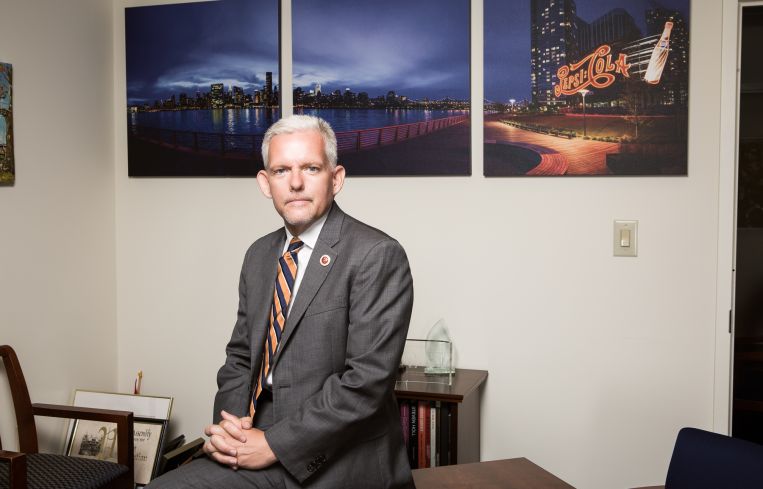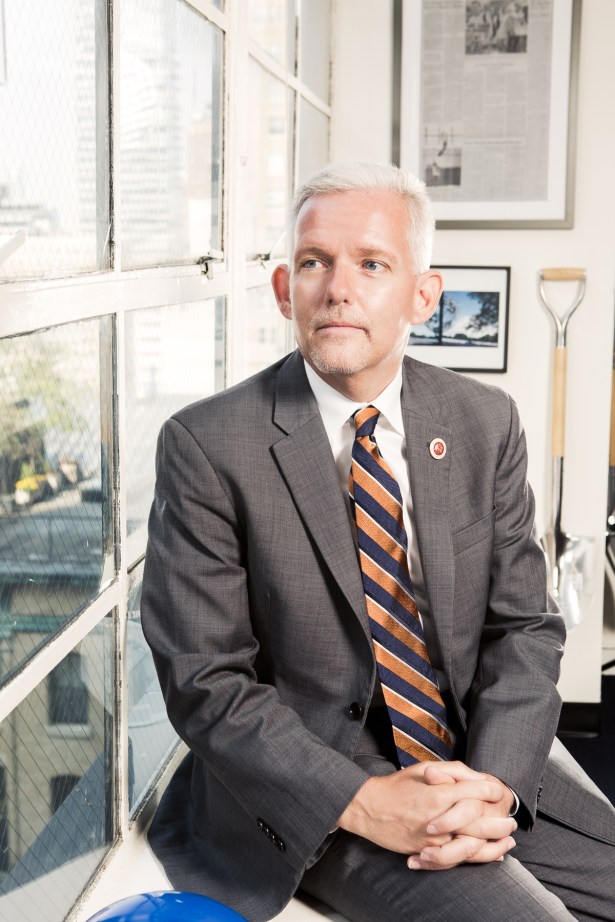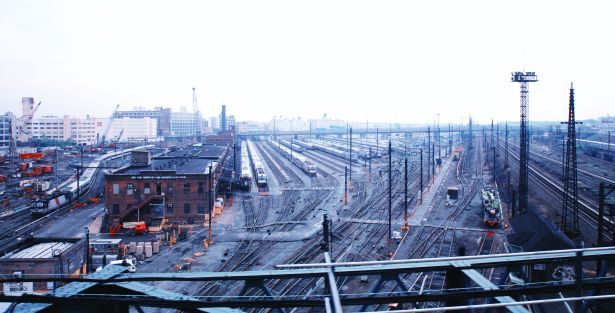Jimmy Van Bramer on Long Island City Development, BQX and the Queens Political Machine
By Rebecca Baird-Remba September 11, 2018 1:13 pm
reprints
City councilman Jimmy Van Bramer presides over one of New York City’s hottest real estate markets: western Queens. And one of its submarkets, Long Island City, is on track to get 6,200 new residential units by next year and sits at the heart of crucial zoning, infrastructure, transportation and urban planning issues that affect much of the city.
The 49-year-old councilman, who represents LIC, part of Astoria, Sunnyside and Woodside, was raised in his district by a printer father and painter mother, both union members. Since taking office in 2009, he has found himself facing down developers and community activists alike, while trying to stay true to both his core principles and his working-class neighborhood roots.
Over the past few years, he’s netted some victories for his district, like a new modern library for Hunters Point South in LIC and protected bike and bus lanes along Queens Boulevard. He’s also run into controversy over development and transit issues, like when he refused to greenlight a 2016 rezoning for a 200-unit affordable apartment building developed by Phipps Houses in Sunnyside. And last year he clashed with neighbors and businesses along Skillman Avenue in Sunnyside for proposing protected bike lanes there and along 43rd Avenue after two cyclists were killed by motorists. (After getting pushback from local merchants and the community board over bike lanes replacing parking spots, he abandoned the plan. Congressman Joe Crowley—recently unseated in a surprise victory by democratic socialist candidate Alexandra Ocasio-Cortez—even weighed in on Twitter to oppose the bike lanes.)
Van Bramer is also contending with Brooklyn-Queens Connector (BQX), the controversial $2.7 billion proposed streetcar line that City Hall pushed into the public review process two weeks ago in an effort to link the Brooklyn and Queens waterfronts with a single from of transport. It’s expected to take more than a decade to approve and build.
Commercial Observer sat with the third-term politician last week to talk about the eight proposed rezonings in LIC, transportation and infrastructure and his recent endorsement of Zephyr Teachout in the state attorney general’s race.
Commercial Observer: How do you feel about the latest news about the BQX and its potential impact on western Queens? What do you think of the critics who think it’s an expensive boondoggle that’s going to take forever?
Jimmy Van Bramer: We are an area of the city that people call “transportation rich” all the time. And yet I always tell folks that it’s not transportation rich if you can’t get on the 7 train or the E train. So we need transportation options; we need more, new and better when it comes to transportation. While I’ve always been dubious when it comes to the BQX, I haven’t slammed it because I think you need to investigate whether it could be real or feasible. But nothing about this plan has seemed real, feasible, tangible. It’s always taking steps backwards and not forwards. It looks like it would cause a huge disruption along Vernon Boulevard. It would be problematic. The idea of a new bridge connecting Brooklyn and Hunters Point seems like a good thing. But I just don’t see it happening. [It has a] start date of 2024 [with expected completion in 2029], so it wouldn’t get to Long Island City until sometime in the late 2020s. We’re an area that screams out for additional bus service.
So rather than asking my constituents in Long Island City to wait another 10 years for this thing to maybe happen, why don’t you take a fraction of the money you’re hoping to spend on this and spend it on new bus service, which you could then deliver to people much more quickly and alleviate some of the infrastructure pressure that exists in Long Island City. This administration needs to start addressing the infrastructure issues in Long Island City. And this to me is like a false hope that we’re doing that.
City officials have readily admitted that the route was planned based on where the city has significant investments. Do you think it makes sense that it’s just driven by specific pockets of real estate development?
No, I don’t think massive, multibillion dollar transportation infrastructure enhancements should be dictated by luxury development in the City of New York. Obviously where there are new people coming because of new development, the city must responsibly think about how those people will get to and from work and their apartments. So, yes, there should be a thought—particularly in Long Island City—about how we’re going to move the additional people in the neighborhood but that is not where I think this came from. Obviously the administration talks a lot about public housing residents—in Queensbridge and Ravenswood in my district and up to Astoria Houses in the north—but I think if the city is being honest it’s much more driven by the new development and less by public housing.

Let’s talk about the Skillman Avenue bike lanes in Sunnyside, where it seems like you changed your position.
I don’t think there’s anything more contentious in the city right now than bike lanes, which I think is shocking on some level because bike lanes are good. I believe bike lanes make it safer for everyone: pedestrians, cyclists and motorists alike. I supported the protected bike lane and safety enhancements along Queens Boulevard. Between six and 18 people would die every year getting hit by a car along Queens Boulevard. The city came to me with the idea of safety enhancements including a protected bike lane on Queens Boulevard. I knew it would face some opposition; it did. But I supported it, made it happen, and not one person has died in almost four years on Queens Boulevard since we installed the bike lanes. No matter what happens in my political career, that will be one of the things I’m most proud of.
This debate about Skillman and 43rd Avenue. First let’s keep in mind that it took center stage after two people [were hit]—not just Gelacio Reyes who was killed on 43rd Avenue and 39th Street, but another person who was run over by a truck in the same intersection in the same spot 10 days later. I called for a protected bike lane on 43rd Avenue. I never wavered from that; I supported that the whole way through. The [Department of Transportation] came back with a plan that included Skillman Avenue. It met with significant opposition from local business owners. Of course, I live in that neighborhood. It became very personal and divisive in a way I could never have anticipated. I thought there was a way for me to hear and listen to the opponents and try to address their concerns in a way to move the project forward. It became clear there was not a compromise to be had.
While at the town hall meeting I said I was for protected bike lanes. This is who I am, in my statements, even the one where I said I don’t think we can move forward at this time. In hindsight I should have done it differently, I should have said all along that I’m in favor of this project. But I felt like we needed to have this community-driven process which ended up being incredibly contentious with no real compromise possible. And so it was brutal. And still is.
But I’ve been very honest all along in saying that the mayor and the city had the ability to make this happen regardless of what my opinion was or the community board’s opinion was. When I realized the mayor was going to move forward with this plan no matter what, I had a choice of either fighting it, which meant fighting what I personally believed, or saying what I believed honestly, which is that this is the right thing to do. I acknowledged my mistakes and said you know what, I’m in favor of this. And I know that that is something that some people are upset about.
I know a lot of people in western Queens are concerned about how the huge influx of residential development in LIC is overburdening the existing transit system. What subway upgrades or transit upgrades would you want?
First, I’d ask for a reliable 7 train. The MTA has got to get their shit together on the 7 train. The service is unreliable—the waits on the platforms, the signal issues. They’re all chronic and they’ve just gotta fix the 7. Obviously, there are other lines, like the E, that also present problems in terms of congestion and reliability.
Just as with the BQX, we are not going to build a new subway line in our lifetimes. So what we have to do is focus on transportation and infrastructure that people could actually realize in the near future that actually makes our lives better. So that’s why we focus a lot on bus service and making sure the city is looking at SBS express bus service, new dedicated lines in and around Long Island City to get people both north and south and east and west. That’s doable, that can happen. Obviously, we need expanded and reliable ferry service. We have Citi Bike, and Long Island City was the first neighborhood to get it. I think the city should build a pedestrian bridge between Hunter’s Point and Manhattan. That’s really what they should do, if we wanted to move people back and forth in a way that eased pressure from the 7 line and made it possible for people to get to and from Manhattan.
Do you feel optimistic about the future of Sunnyside Yard, or is it kind of a pipe dream?
Sunnyside Yard is perceived as a glorious opportunity for some. At the same time, it is absolutely frightening for many people who live in the neighborhoods that surround it. And I think this is the most serious attempt at pursuing development in Sunnyside Yard. While there have been lots of efforts and designs and plans over the years, there’s very little support for this project in the neighborhoods that I represent. It’s almost impossible to conceive of this project being feasible given all the very real infrastructure issues we already face. I could never and will never support megatowers and a mini-city being built on Sunnyside Yard. It’s out of character with the Sunnyside and Astoria neighborhoods that are to the north and south of it. How about we address some of the infrastructure issues before we contemplate something like Sunnyside Yard, which [could produce] up to 24,000 units of new housing?
Do I think that’s going to happen anytime soon? No. But by the administration pursuing all of this concurrently, it produces a great deal of anxiety in the neighborhoods I represent. I think it’s fair to say that I don’t support it because I don’t see the administration meaningfully adding infrastructure today.
And there’s the city-backed Long Island City Core rezoning proposed for the eastern side of the neighborhood, by Sunnyside Yard. What’s going on with that?
Nothing can go forward and I won’t approve anything unless I think the community has the infrastructure and the services they deserve. I am still pressing the administration to come forward with stuff. But more than simply about what we get in exchange for new development, we should be talking about what the community needs and how to plan better going forward because the rezonings that took place in ‘01 and ‘04—there wasn’t planning. And I take great exception to those rezonings that took place before I was in office. We got almost no benefits out of that. We got enormous amounts of luxury development without a school—without one school. How do you even do that?
We’re still fighting, and I had to put $15 million more for the library that’s being built now at Hunters Point South.
We had two rezonings that just massively upzoned Long Island City and produced almost no infrastructure additions to the community—I’m not going to repeat the mistakes of my predecessors. I take some exception to the path the administration has outlined by choosing to go the private application route while seemingly putting on the back burner the core rezoning which is a larger, bigger picture look at the portion of the neighborhood in favor of the cheaper private application route.
And I think by doing it in this way it’s not actually seeing it as one neighborhood. A whole section of my district is—literally, in some cases—crying out desperately for these services and for infrastructure. Our police precinct, the 108th Precinct, needs more police officers. Sanitation services in some cases have not kept up with the increase in population. To go back to the community now and say we want to add 10,000 more units of housing when we don’t think this administration has meaningfully addressed the infrastructure issues of what we’ve got now…

There was an epsiode two years ago where you refused to approve a rezoning for Phipps Houses, and the developer withdrew its application to build a 100-percent affordable apartment building in Sunnyside. I’m curious what happened with that. And would you do that again with one of these private rezonings if you felt it wasn’t going to be beneficial to the neighborhood?
Absolutely, I think there were some real issues with Phipps. I took it on the chin from the editorial boards on that one. And, look, it was a tough local issue but there were two things. Phipps is still scratch-your-head resistant to working with 32BJ [SEIU, the service workers union]. And the tenant association at the Phipps Garden Apartments continued to oppose the project and pointed out issues with the existing Phipps rental complex with several hundred units, which they’ve owned for like 80 years. It’s a lovely complex but the tenant association pointed out lots of issues with the existing buildings. And I spoke to Adam [Weinstein, the president and CEO of Phipps Houses] and they have worked with the tenant association to try to work with some of those issues. While I got attacked, if [those issues] weren’t real, Phipps wouldn’t have had to invest a million, $2 million to address those issues, which they did.
Am I prepared to say no to new projects? Absolutely. Am I universally opposed to everything? No. But even if I get criticized, I am willing to say no when I need to and stand with my community. Even if it’s unpopular in some circles.
Do you have any plans to run for higher office?
I really liked being a city councilmember. I think we’ve been really successful on a lot of important endeavors. I think I’d like to continue in public service. As a kid who was born and raised and lived my entire life in Queens I’ve thought about serving the entire borough and running for Queens borough president. I like that idea a lot. I haven’t made a final decision or declared, but certainly I’ve opened a 2021 campaign committee and we had a very strong financial filing and we continue to talk to lots of people.
You switched your endorsement in the attorney general race from Tish James to Zephyr Teachout. You said you felt like things were shifting away from machine politics and power broker-anointed candidates. What do you think is happening with the Queens political machine?
Anybody who has watched me in my political career knows that I am in my heart and soul an insurgent. Not only did I run against the machine in 2001 for City Council and lose only to come back eight years later and run for City Council against the machine and win, but then in 2013, when we had the speaker’s race and I was faced with probably the biggest and most intense decision of my career which was: Do I go with the county machine and support a candidate, or do I stick with progressive labor and the working families party? I chose Melissa Mark-Viverito and once again showed my independent streak. When it counted, when it was really on the line, I supported my values and did not support the machine.
So you still feel Tish was more representative of the establishment?
I will say that in this particular race and in this particular moment, Zephyr Teachout’s campaign and how she’s running her race is more emblematic of where I think we as a society should be moving and where I’m at. We’re going to do politics differently. We’re going to amplify the voices of the grassroots, of all those moms in Sunnyside who just wanted to run for county committee when most people have never run for county committee, but who were all thrown off the ballot in some messed up political machinery move.
I think that’s fundamentally wrong. I think Zephyr represents one of our best hopes to build on the momentum that’s been happening that obviously Ocasio-Cortez’s victory just exploded into the universe.



